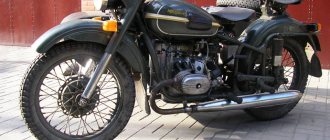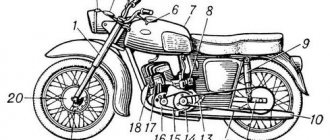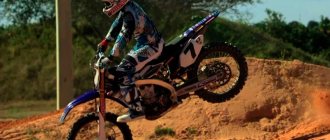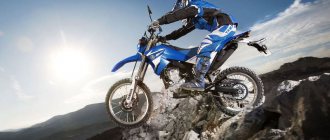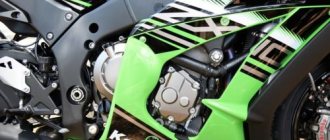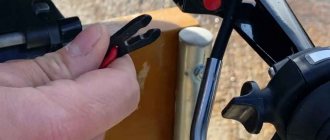No matter how much I studied on my own and took private lessons, my head was constantly a mess of disparate knowledge. Anton and Denis put everything in its place from the very first lessons. The first turn after the start line was, frankly speaking, not successful for me before. Now this is one of my favorite places on the track. Good acceleration, sharp braking to the apex while leaning, and almost full throttle - now this is the only way! The S began to turn out much better when I realized that between apexes I had to go at a steady “throttle”, and not “open” and, as a result, fly out strongly. I still get jittery before a pseudo 90-degree turn. There is always someone falling and trying to take me with them.
The Motoexpert magazine, based at the Anton Bezshlyaga Academy of Motorsports, begins a series of educational articles devoted to the theoretical foundations of road-circuit motorcycle racing. Experienced instructors Anton Bezshlyaga and Denis Yadak will share subtleties and secrets with you. Mikhail Pimus, who completed the basic practical course at the academy, will talk about his successes and achievements. As a clear example, the newly opened everyone’s favorite karting track “Leader” will be used.
A whole bunch of essentially good books have been written on circuit racing. But even if you read them all carefully, you most likely won’t learn anything. Do you know why? There is simply nowhere to apply this knowledge, and some of it is completely outdated. Theory without practice in a specific case will lead to nothing. Each line read separately must be immediately felt in action. Knowledge must be layered and adjusted over and over again. Only then will there be a result.
We will specifically give you information with a very close connection to the “Leader”. It’s easier to learn from ready-made examples. Under our dictation, you can do as much practice as you need. Comparing your feelings and our explanations, if you have a certain perseverance, good equipment and properly prepared equipment, after studying the Leader karting track, you will subsequently be able to independently master any other track. It's never too late to start learning. The more track riding techniques you master, the more free you will feel on a motorcycle. Including when driving around the city.
The publication plan is approximately as follows. In the next two materials we will look in detail at how to properly drive a lap on the Leader karting track. Then we will take a closer look at trajectory construction, braking, taxiing, landing, winter preparation and some other important aspects.
Features and Rules
In fact, road racing (or simply GCR) is not exactly a discipline, but rather a separate area, including several types of racing and being the complete opposite of off-road competitions. In this case, all events take place on specially organized asphalt loop tracks. Unlike a speedway, where the main emphasis is also on speed, tracks for the GCS are longer (at least 3 km) and have a complex shape, including not only straight lines, where motorcycles can reach maximum speed, but also a large number of turns.
The duration of the race is usually stated in the number of laps and depends on the class of motorcycles participating. In any case, the start takes place simultaneously from the starting grid, which places the participants in a checkerboard pattern. Starting positions are determined by completing a qualifying lap (or laps) against the clock. If two qualifying laps are completed, the minimum lap time will be counted.
The finish of the race is announced when the first participant who has completed the number of laps specified by the competition rules crosses the finish line. From this point on, the remaining participants complete the last lap and finish. A participant who managed to cover more than 75% of the total distance and cross the finish line no later than 5 minutes after the leader is considered to have completed the race.
The distribution of points as a result of each race is made in accordance with the scale specified in the rules. In most cases it looks like this:
| Position | 1 | 2 | 3 | 4 | 5 | 6 | 7 | 8 | 9 | 10 | 11 | 12 | 13 | 14 | 15 |
| Glasses | 25 | 20 | 16 | 13 | 11 | 10 | 9 | 8 | 7 | 6 | 5 | 4 | 3 | 2 | 1 |
If a race consists of a series of stages, the final results are obtained by adding up the results of each stage.
How to choose a motorcycle for a beginner
If you are a novice racer, then you should choose an iron horse that matches your skills. Pay attention to the relevant characteristics of the motorcycle to practice your skills and abilities.
Calm
Such a motorcycle will forgive mistakes such as sudden use of gas or incorrect use of the clutch and brake.
Inexpensive
When choosing a motorcycle, many people think about its visual component more than the price for all this beauty. For example, plastic body kits sometimes cost a lot of money, and sliders and bars cannot always save the body kit from damage. Think ahead about the damage caused by a fall. And believe me, sometimes you will have to fall, because only those who do not drive do not fall. When purchasing related items, it is important not to get carried away and learn to spend money wisely.
Mechanically reliable
The ideal motorcycle for a beginner should be ridden for one season, after which it can be sold. Therefore, everything should be clear with the engine and gearbox. Let's take an example: on a Kawasaki ZZR400, the second gear falls out. The thing is that the developers have built into the gearbox of this motorcycle a “facilitated search for the neutral position”, so this gearbox is super, but on the other hand, this is not suitable for a beginner.
Top tip for a newbie:
When choosing your first motorcycle, you need to remember that this is a motorcycle for one season. Such a motorcycle should simply teach you how to ride, give you the skills to ride around the city, most importantly, make you understand what you want from a motorcycle, cause fewer problems and be sold at the end of the season. You shouldn’t chase after plastic and shine, it’s better to take a motorcycle from the 90s in good condition, the main thing is not to take a rare motorcycle, because it’s difficult to repair and sell.
Kinds
Road racing includes 2 main types of competitions. The key difference between them is motorcycles.
MotoGP
MotoGP (MotoGP) is the most prestigious, expensive and definitely the most famous GCG in the world. First of all, they gained their fame thanks to the models of motorcycles they used and their enormous speeds.
Motorcycles
MotoGP bikes are akin to Formula 1 cars - they are in no way intended for use on public roads and are built from the ground up specifically for racing. These are not even production models, but prototypes, existing in 1-3 copies. This approach allows you to carefully consider every detail: from engine tuning to aerodynamics and weight distribution.
By the way, MotoGP “cars” are quite heavy - the average weight of an empty motorcycle is 157 kg, and it is achieved artificially - engineers place additional weights in the lower part of the frame, shifting the center of gravity and simplifying control when cornering. However, this does not make driving the car any easier: due to the heavy weight, a 40-minute race is comparable in load level to a 2-hour gym session, and in one race each athlete loses about 2 liters of fluid through sweat.
As for speeds, this type of racing is far ahead of other disciplines: the average lap speed is more than 165 km/h. It is achieved not only by maximum acceleration on straight sections, when speeds reach 350 km/h, but also by smooth turns, which practically do not force you to slow down.
Competitions and classes
The situation with the competition is very interesting, since the direction itself received its name from the most important race - the World Championship Grand Prix (aka FIM Road Racing World Championship Grand Prix).
It was first organized in 1949. At that time, the test was carried out in 4 classes, as in other disciplines corresponding to engine size:
- 500 cm3,
- 350 cm3,
- 250 cm3,
- 125 cm3.
Actually, the classification, apart from the logical development and complication of the motorcycles themselves, is practically the only aspect of the competition that has changed over time.
Currently, races are held in the following classes:
- MotoGP is the main and most prestigious class, which includes the most powerful motorcycles with 4-cylinder, 4-stroke 1000 cm3 engines.
- Moto2 – models with 3-cylinder 765 cc engines.
- Moto3 - motorcycles with single-cylinder 4-stroke engines with a displacement of 250 cm3.
- MotoE is the youngest class, included in the program only last year, allowing the use of a single motorcycle model - the Energica Ego Corsa, built on the basis of an electric motor.
Superbike
The situation with MotoGP has always been extremely strange: despite its enormous popularity, the threshold for entry into these races for athletes was and remains not just high, but practically unattainable - the cost of one motorcycle now reaches about 1.2 million euros. All this contributed to the emergence of the second type of GCS competition - superbike. In fact, they are carried out according to the same rules, but using mass-produced models of sports motorcycles.
Motorcycles and classes
Superbike motorcycles are created according to one simple rule: they must be based on serial sports models, and their modernization must be carried out only with parts available for free sale. The most popular sports bikes for these purposes are produced by the Japanese brands Honda, Suzuki, Yamaha and Kawasaki, German BMW, Italian Ducati, and a number of other brands.
The features of motorcycles are best told by the established competition classes:
- Superbike is the most heavily modified motorcycle model with a 2-cylinder 4-stroke engine with a volume of 850-1200 cm3, or a 4-cylinder 750-1000 “cc” engine and the mandatory installation of racing tires - slicks.
- Supersport (aka Middleweight) is a “middle class”, in which 4-cylinder motorcycles with an engine capacity of 400-600 cm3 or 2-cylinder 600-750 “cc models” participate. The overall level of modifications is significantly lower compared to a Superbike, and the main difference can be considered the mandatory use of standard road tires.
- Superstock (Lightweight) is the “entry point” into the world of GCS for beginners. The races involve slightly modified or simple production models of sportbikes with engines up to 600 or up to 1000 cm3.
Competitions
The most significant competition, as you might guess, is the Superbike World Championship or simply WSBC. It was first organized in 1998 and has been held on a regular basis since then. The race is a series of stages, each of which includes 2 full races. Since last year, they have also added the so-called Superpole - a qualifying sprint of 10 laps. The results of the riders are taken into account to determine the winners of two championships at once - among riders and among manufacturers.
The World Championship is far from the only superbike competition. Firstly, there are also world supersport and superstock championships. Secondly, most large countries host their own national events:
- MotoAmerica Superbike Championship in the USA,
- Mopar Canadian Superbike Championship in Canada,
- British Superbike Championship in Great Britain,
- All Japan Superbike Championship in Japan,
- Australian Superbike Championship in Australia and so on.
Russia also hosts major competitions - RSBK, and the “Russian Superbike” is not a small local competition, but an event of international scale, organized under the auspices of the FIM and with the support of the Russian Motorcycle Federation.
The first Championship was held in 2012 and has been organized annually since then. At the moment, it includes 2 classifications at once: international and the Russian Championship, which is held in 7 classes, including superbike, supersport, superstock, a separate class for women, “open stock” and others.
A little history
So, the starting point in the development of motorcycle racing as a professional sport was the emergence in 1904 of the International Motorcycle Federation, designed to become the main controlling body of the entire field of motorcycle racing. Under her leadership, they began to develop and branch out quite rapidly, forming more and more independent and, often, completely different directions.
The first can be considered the appearance of motorcycle racing on a cinder track, which took place in 1907 in the USA and at about the same time in England. Previously, all competitions involving “single-track mechanical carriages” were long-distance races held on public roads. This created at least two problems: an increased risk of injury due to the close proximity of ordinary pedestrians and difficulty in viewing, which means little interest on the part of spectators.
The transformation of the competition into a local event, held first at racetracks and bicycle tracks, and then on special closed tracks for motorcycles, not only solved both problems, but also worked to popularize them - spectators could freely watch the confrontation between high-speed cars. The chosen strategy turned out to be correct and the competition became annual.
To date, there has been a decline in the development of motorcycle sports - new directions and disciplines have practically stopped appearing. However, this absolutely does not mean stagnation of the entire movement: if you look at the calendar, you will notice that races in various disciplines around the world take place literally every day, attracting hundreds and thousands of spectators. Moreover, teams are replenished with new athletes, changes are made to the rules, new models and modifications of motorcycles appear, and unofficial types of motorcycle sports are gradually developing and gaining popularity. This means that the world motorcycle sport, even more than a hundred years after its inception, continues to live, develop and successfully improve, attracting more and more new fans.
Where to start practicing
Getting into the sport is not difficult: sign up for a special training center, rent a motorcycle, buy the necessary equipment and begin training under the guidance of a professional trainer. If you want to go further up the professional career ladder, then you won’t be able to do this without sponsorship, since participation in championships, as well as maintaining a team and a motorcycle, cost a lot of money.
The competition among Russian racers and their level are only growing year by year. Of course, last year the pandemic had an impact on the races, but they were canceled all over the world, and pilots competed online. But historically, road-circuit motorcycle racing in Russia has developed restrainedly due to objective factors - the weather, high cost and inaccessibility of infrastructure for constant training in many cities. In Russia you can get all the necessary base, but to continue your racing career you need to participate in foreign international competitions - this is a completely different league with an exorbitant level of competition. It is much more difficult and interesting to perform there, and you can learn a lot.
Spain, France, the United Arab Emirates and Australia are considered leaders in the development of this area. These countries have excellent tracks with high-quality surfaces, allowing them to host championships at various levels.
